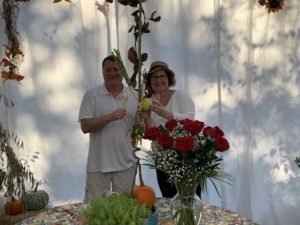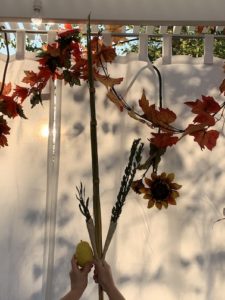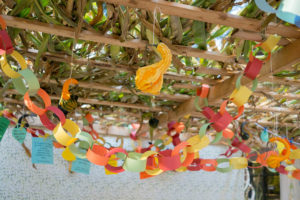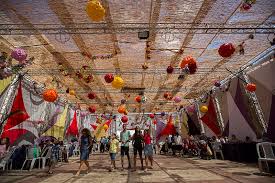Our Anniversary In The Sukkah
Twenty seven years ago, my husband and I stood under the huppa (chuppa) and made our vows to stick together through the best and worst of times and everything in between. We made a commitment to create a life together based on Jewish values under the watchful eye of God, that’s what a huppa is all about.
Today, on the last day of Sukkot, which is also Shabbat, known as Hoshana Rabbah, we are renewing our vows to each other and, by doing certain rituals under the sukkah, we are renewing our vows to God and the the Jewish people.
When I was a bride I clutched a bouquet of ivory roses as I walked down the aisle towards my soon-to-be husband who stood under the huppa waiting for me with a nervous smile on his face. Today, I hold in my hand the sweet smelling fruit called etrog (esrog) with the palm, myrtle and willow branches of the lulav, and wave the Four Species together in all directions in the sukkah. Scott’s still smiling, but this time because I’m shaking my lulav and we’re having strudel for dessert.
Lulav and Etrog Symbolize Unity
I have chosen Sukkot as the theme of this year’s anniversary–why not–considering the actual modern gift associated with the 27th year is “sculptures.” So, here’s my attempt to connect the meaning of the sanctity of marriage to this joyous holiday.
The lulav and etrog can be compared to a married couple, who bring their own unique qualities and strengths to a relationship. A lulav is a slender palm branch that is held together with two willow branches and three willow branches. An etrog, or citron, looks like an enlarged bumpy lemon and a whiff of the subtle scent is heavenly and intoxicating. Together, the branches and fruit have their own beauty and symbolism.
A midrash explains that the Four Species symbolize the importance of unity among different types of Jews. The etrog has both a flavor and a scent, like a Jew who is both learned and observant of the commandments. The lulav is from a date palm, and so it has a taste but no scent. It is likened to a Jew who is learned but does not apply that knowledge in action. A myrtle has a pleasant odor but no taste, and it represents the Jew who has little book learning behind his or her observance. Finally, the willow lacks both fragrance and taste, just like the Jew who neither studies the Torah nor keeps the commandments. These differences among Jews are substantial, yet we can still come together in solidarity, just as the lulav and etrog are bound together to merit a blessing. Same as a married couple. We bring our own unique qualities to the relationship, and we are better, stronger when we are committed as one.
Raise The Roof On The Symbolism of Sukkot
You shall dwell in huts (sukkot) for seven days. Every member of the Jewish people shall dwell in huts, so that your generations shall know that I had the Israelites dwell in huts when I took them out of Egypt.
Many years ago when I built my first sukkah in my own backyard, I was super excited to find a pile of freshly cut tree branches in the temple parking lot in carpool line.
It was fate. Or as we say in Hebrew, kismet. Since nobody else was claiming this tree limb treasure, I somehow managed to drag the logs like a lumberjack to my van and shove the messy branches into my newly vacuumed back seat. Little did I know these leafy sticks that I was about to lay on the roof of my sukkah had a name, s’chach  and I was doing a mitzvah. Continue reading
Sukkot Celebrates Bountiful Harvest with Family, Friends, Food & Fun
The week-long festival of Sukkot, the Hebrew word for “booths,†begins when the sun goes down tomorrow night (September 23-30), and is considered one of the happiest times in the Jewish calendar. When else are we commanded to build a hut-like structure, called a sukkah, in our backyard, decorate it with fresh fruit, gourds and other Judaica ornaments, and get to eat our meals alfresco and even sleep under roofs of branches open to the stars? Continue reading
Sukkot: What We Learn When Our Walls Come Down
When Yom Kippur ends, another Jewish holiday begins. Sukkot! This week-long pilgrimage festival (October 5-13, 2017) commemorates the time when Israelites wandered the desert for 40 years after escaping from slavery in Egypt. The Jewish people built temporary tent-like structures to sleep, eat, and dwell in, and it’s a mitzvah for us to build a sukkah and to immerse ourselves in nature and God’s presence. At this time in our world, when everyday seems to bring another natural or manmade tragedy, from the hurricanes to mass shootings, we are reminded of how vulnerable we really are. The safety of four concrete walls can’t protect us from harm. Also, when we isolate ourselves in our shelters, we can’t connect with each other. So, Sukkot is a time for our walls to come down, for us to be in touch with not only nature and with God, but also with each other. During Sukkot, we are reminded that God’s presence is bigger than all of us. Sukkot, yet another opportunity to make the ordinary–like an outdoor hut–holy again. Continue reading





